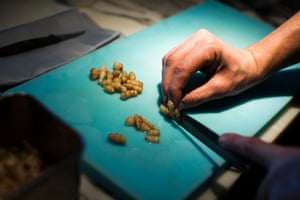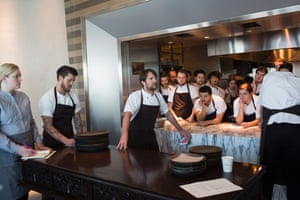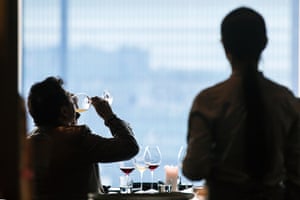René Redzepi uprooted his award-winning restaurant from Copenhagen to Tokyo for a month. ‘There’s a huge chance of failure,’ said the chef as OFM joined him behind the scenes before the big opening
The kitchen was two courses into its trial run when something began to go terribly wrong. Made from several varieties of local fruit set in a pool of kelp oil and dotted with tiny rounds of sancho pepper, the citrus dish’s bright juiciness and deep savouriness were delicious enough to encourage bowl-licking. But you can’t lick a bowl you don’t receive. Meant to contain 11 perfectly rounded segments of fruit, freed from their bitter membranes and carefully trimmed so as to remain upright, each portion had to be made à la minute, which is to say in the tragically short interval between when the live shrimp for the first course were relieved of their shells and the shavings of frozen monkfish liver for the third were placed onto their rectangles of sourdough toast. In the rush, some citrus pieces emerged with edges less seductively curved than others – a flaw perceptible only to the increasingly agitated chef, who sent dish after imperfect dish back to be remade. Out in the dining room, the restaurant’s front of house staff – the beneficiaries of that night’s practice dinner – waited with polite restlessness as the dish failed to appear. Sommelier Mads Kleppe gazed balefully at the empty place setting in front of him. “If this were any place but Noma,” he sighed, “I’d be worried.”
With two days to go before they opened at the Mandarin Oriental Hotel in Tokyo on 9 January, the staff of Noma had no shortage of things to worry about. There was the entirely new menu made from ingredients most of the staff had never seen before, let alone cooked with. There were products that appeared one day, only to become unavailable two days later. There was the formal dining room, complete with ornate moldings and a mirror-trimmed pass, that had to be transformed into something more suitably Nordic. There was the jetlagged staff putting in 20-hour days, and the reservation requests that came by the tens of thousands, and the kind of extreme pressure that only legions of clamouring journalists, bloggers and photographers can engender. But mostly there was the simple fact of it: the restaurant considered by many to be the best in the world had temporarily uprooted its staff from home in Copenhagen to a place literally and figuratively a world away. And no one – not even René Redzepi, the chef whose wildly ambitious dream this was – knew if they could pull it off.
In terms of its bookings, the “residency” was a success before it opened: every single one of the 3,456 reservations was snatched up within a day of being offered, while 58,000 people were shunted to the waiting list. But in every other aspect – food, service, finances, and reputation – Noma Japan is the riskiest thing the 37-year-old Redzepi has ever done.
Head chef Daniel Giusti and René Redzepi discuss the menu and guest list at Noma.
Like many risky ventures, it was born of a bad experience. “You know what really made me decide to do it?” the chef asks. “Norovirus.” Redzepi first visited Japan in 2009, and fell in love with the country, its culture and its food. He had toyed with the idea of doing some kind of project there, but it took a 2013 outbreak, which sickened 63 of Noma’s customers and unleashed a tide of negative media coverage, to make him pull the trigger. “Everyone was shattered by that,” he says. Noma dropped to No 2 on the World’s 50 Best Restaurants list, and that made it even worse. “We were really down, and needed to do something new, something that would bring us together.” Redzepi told his business partner, investor Marc Blazer, what he wanted to do. Blazer approached the general manager of the Mandarin Oriental Tokyo, Anthony Costa.
Advertisement
“Here we had the greatest chef in the world, and he wanted to come to Japan,” recalls Costa. “I thought, ‘I have the ability to make his dream come true.’” But it took the citrus – that same citrus that would prove so vexing all those months later – to make the hotelier realise that what Redzepi had in mind was not your average invited-chef gig. “We walked into the banqueting kitchen and René immediately went up to the fruit and stuck his nose in it. He was smelling it, rubbing it, licking it, eating the skin. At first I thought, ‘What the hell is he doing?’ but then I realised that I was witnessing his intensity.”
Although Noma is known for its artful use of only those products that grow in the Nordic region, Redzepi made it clear he wouldn’t be recreating their menu from home. Rather, he and his staff would take their dedication to expressing time and place and apply it to the ingredients they found in Japan. Over the next year, members of his staff travelled eight times to Japan to source plants and seafood. Then, on 1 December, the restaurant’s three senior research chefs – Rosio Sánchez, Lars Williams and Thomas Frebel – arrived to begin testing new dishes. They worked in the dark, hot and cramped kitchen three floors below ground that the hotel’s restaurants use for prep work. By the time that Redzepi and head chef Daniel Giusti showed up in the days following Christmas, the development team had the menu more or less in place.
Admittedly, there were disappointments. They hadn’t, for example, come up with a good enough recipe for the cod milt that Williams in particular was keen to cook with. (“Lars has drunk gallons of cod sperm,” Redzepi chortled to anyone who would listen. “He’s pregnant with cod sperm.”) But with few exceptions, the recipes – the 12 that would comprise the standard tasting menu plus a few options – were startlingly flavourful and visually spectacular. “I’m super happy,” said Sánchez as she folded a shiny, rubber-like sheet of dehydrated black garlic into what looked to be edible origami. “And René’s happy. Which makes all of this a lot easier.”
But developing recipes they were happy with wasn’t the same as serving them to 108 covers a day, six days a week. Japanese chef Shinobu Namae was taking chunks of time away from his own Michelin–starred restaurant, L’Effervescence, to help Noma’s team source ingredients, but even he couldn’t promise their supply. “We need 140 live shrimp every day,” said Giusti. “Maybe they won’t come in because the seas were too rough for boats to go out. Maybe they’ll come in but half of them will be dead.” He rubbed his forehead wearily. “We never know if something is going to work out until we have it in our hands.”

Crown roots preparation. Photograph: Shiho Fukada/Panos Pictures
Unpredictable ingredients weren’t the only thing setting nerves on edge. Still adorned in the formal style of the Mandarin Oriental’s Signature restaurant, the dining room was several chaotic light years away from Noma’s pared-down Nordic aesthetic. The new tables and chairs – designed by furniture maker Carl Hansen and shipped from
Denmark – were still in their crates, the purple velvet banquettes that lined one corner were still in place, and glass walls still divided the room. Each time Redzepi walked by the massive, ornately carved mahogany table in front of the pass, he gave it an angry thump. “Are you sure we can’t do anything about this?”
Advertisement
Money too was weighing heavily on his mind. The Mandarin Oriental had agreed to a generous deal that provided the entire Noma staff, plus some of their partners and children, with housing, meals and laundry for the whole residency. It also granted the restaurant a budget of $140,000 to re-do the kitchen and dining room to its specifications – changes which it would then reverse once Noma packed up. In exchange, the restaurant had to pay a percentage of its sales as rent to the hotel. They would split the reservations between them. Of course, the Mandarin Oriental was also reaping the benefits of having the best restaurant in the world in house. “We didn’t do it for the money,” says general manager Costa. “We’re doing it to inspire our own staff.”
Redzepi also emphasised that he was doing it to inspire and challenge his team. But that didn’t mean he wasn’t concerned about costs. In the early planning stages, he had been cautiously hopeful that the arrangement might actually earn Noma – which in Copenhagen squeaks by on the thinnest of margins – a bit of cash. But a few days after he set the price of the meal at 40,200 yen (now about £230), the Japanese currency began to slide. It finally bottomed out 12% lower than his team had budgeted, and instead of hoping they might turn a profit they began praying to break even. Yet even that diminished goal was looking uncertain. For one thing, the restaurant had banked on 80% of its diners choosing the wine pairing – at an additional cost of 27,400 yen – to go along with the tasting menu. But in the pre-bookings, a mere 18% had opted to do so.
Expenses were just as painful. The live shrimp cost $8 a piece. The uni [sea urchin], which wasn’t even as good as the stuff they had delivered live at home, was $12 a portion. A single tuna collar – which Redzepi hoped to serve to VIP guests as an extra course if he and the team could get the recipe right – cost $150, and they tested one a day for a month. All the tableware had been specially made by local artisans for the residency, and was expensive enough ($200 for a plate; $120 for a spoon) that merely thinking about dishwashing gave the chefs palpitations. “The full set for 54 people cost more than it did to fly 70 people over here from Copenhagen,” said Redzepi. Giusti, who until that point had been mindlessly playing with a set of chopsticks ($80), gingerly set them down.
 Facebook Twitter Pinterest
Facebook Twitter Pinterest Redzepi speaks to the team during a meeting before lunch. Photograph: Shiho Fukada/Panos Pictures
Yet of all the anxieties under which the Noma chefs worked, the pressure of getting it right was the worst. In Japan,
Noma has been under intense scrutiny from the media. Food writers from around the globe rushed to get seats at the opening of the year. So too did prominent chefs: Massimo Bottura, Bo Bech, Ivan Orkin, and most dauntingly of all, the 89-year-old sushi master Jiro Ono. Even foodies without reservations turned up in Japan, hoping to get, if not a last-minute opening, then at least the chance to say they were in Tokyo at the same time. “Everybody’s coming, and if they’re not coming, they’re watching,” says Redzepi. “We have western chefs asking why we’re not making “our” food, and Japanese chefs saying we don’t know what we’re doing, look how those idiots cook tofu. There’s a huge chance of failure.”
Advertisement
Waiting for the elevators one day, Frebel mentioned innocently that he hated not being able to open the windows in his room. Redzepi bristled. “You have this amazing opportunity and you’re complaining?” His voice rose. “You have the rest of your life to open windows.” But the outbursts were relatively few. Creatively, Redzepi is invigorated rather than paralysed by the fear of failure. When the bus containing the rest of his staff pulled up to the hotel, and those who had already arrived came out to welcome them, his excitement was infectious. “Guys,” he said as he scanned the bleary, now smiling faces in front of him, “we have the chance to do something extraordinary here.”
Admittedly, the extraordinary began with a specimen jar. At their initial briefing, the staff learned Japan has its own problems with norovirus, and the Noma team would be expected to follow the hotel’s preventative protocols, including a semi-monthly stool sample. But it wasn’t long before they got down to work. In the kitchen, chefs taught cooks each of the new dishes, showing them how to arrange the glazed cuttlefish so it looked like a neat row of soba noodles, and reminding them that they had to cut the citrus as precisely as sashimi. The freshwater shijimi clams solicited a special degree of disbelief. Set atop a kombu tart spread with wild kiwi (“like a bad pizza,” Redzepi joked), the clams were each the size of a hazelnut. It required a kilo to make three portions, it took 14 cooks three hours to open enough for a single service.
Initially, things were a little calmer for the dining room staff, for the simple reason that they didn’t yet have a dining room to work with. The design team was still unrolling rice paper over the glass divider walls that Redzepi hated, still putting together the tables, and still building – from scratch – a mud-walled private dining room. One designer spent a day pruning the five or six bamboo plants that had been brought in, then straightening their leaves, one by one, with a hair iron. The front of house used the time to train the Mandarin Oriental staff who would be joining them in Noma’s warm and informal style of service. When manager James Spreadbury explained that he might occasionally take his leave of a customer with a friendly high-five, a look of terror collectively crossed their faces. But the relaxed dress code went over far more easily. “Do you mean,” asked one in a breathless whisper, “that we don’t have to wear heels to work?”
Meanwhile in the dining room, general manager Lau Richter was struggling to come up with a solution for the dining room cabinets that would house the fleets of glasses needed during service. He had chosen the cabinets back in Copenhagen, but now that they were in the Mandarin, they looked out of place, and Redzepi was unhappy. “They’re unacceptable,” the chef said. “They look like they belong at a Thai beach resort.” Shoulders slumping, Richter set off to investigate his options.
Hours later, he was still pursuing solutions when the trial run started. Redzepi was furious: how could the manager communicate to the others what the dishes tasted like if he hadn’t tasted them himself? (Lau would have a chance the next day). But it was hardly the only problem. Waiters had to dodge the ladders of the still-unfinished designers. There were long waits between the courses and in some cases, including the citrus, the kitchen couldn’t manage to prepare enough plates. The ducks burnt and had to be remade. Bad jazz seeped into the dining room from the lounge next door. When it was all over, Giusti looked as though he was trying to shake off a bad dream. “That was painful.”

Patrons dine at Noma in Mandarin Oriental, Tokyo. Photograph: Shiho Fukada/Panos Pictures
The next morning – the day on which the kitchen would open for a soft run for friends and family – everyone looked worse for wear. No one had left before 1am the night before and some – like Richter, who was still trying to fix the cabinet problem – had stayed until 5am, long enough to welcome most of the cooks back to work. One sous chef had already lost his voice; another gulped paracetemol. Giusti in particular looked like hell; his eyes were so swollen from allergies or stress that a doctor had to make a kitchen house call to deliver a cortisone shot. Cans of Red Bull were passed around the kitchen. Redzepi strolled in and cheerfully opened the blinds on the floor-to-ceiling windows. For what was already the thousandth time, everyone turned instinctively to gaze at Mt. Fuji in the distance.
Advertisement
“It’s a symbol for us,” he said. “That’s the mountain we have to climb.”
“The mountain we have to climb barefoot,” added Richter.
“Barefoot and with someone gripping our balls,” replied Redzepi with a grin. All was forgiven.
To everyone’s delight, the meal for friends and family on 8 January went smoothly. The diners were audibly enraptured by it all: the silky richness of the fresh-made tofu and the earthy sugar of a sweet potato dessert; the warmth of the service staff; the unforgettable sight of the sun setting over Fuji. There would be more obstacles to come on when the restaurant opened to the public the next day: a $200 plate broke; the design team was still trying to cover up the mirrors on the pass an hour before the start of service; the dishwashers got sick, forcing two of the Mandarin Oriental managers, dressed in ties and formal slacks, to step behind the sink. Only 10 of the really good botan ebi came in that day so the kitchen had to round out the live shrimp course with langoustines. But when Redzepi asked his exhausted staff that night if it was worth getting rid of the preparation-intensive shimiju clams so that they could get two extra hours of sleep, he got a resounding “no”.
Their determination surely helps explain why Redzepi was already thinking about the future. After the last of his first paying customers in Tokyo had left, he stood with Williams and Giusti in the temporarily quiet kitchen. “Just wait,” he said. “By next week, we’re going to start getting bored.” He sucked at a bit of leftover grapefruit until a mischievous smile crossed his face. “We’re just going to have to come up with something new to do next.”









